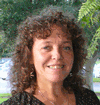Research Terms
Computer Science Computer Applications Computer Simulation and Modeling Computer Hardware Computer Peripherals Computer Methods Computer Graphics Computer Programming
Industries
Digital Media Microelectronics & Computer Products Modeling, Simulation, & Training (MST) Software & Computer Systems Design
UCF researchers have developed a method that quickly generates realistic synthetic data and enables gesture recognizers to significantly improve their accuracy. The new method, called Stochastic Resampling (SR), is computationally efficient, has minimal coding overhead, and does not require expert knowledge to implement. SR-generated synthetic samples also outperform those of competitive, state-of-the-art methods, namely Perlin Noise and Sigma-Lognormal Model. In some cases, reducing mean recognition errors by more than 70 percent.
Technical Details
SR intelligently selects random points along a 2D trajectory that scales the spaces between the points to create realistic variations of a given sample. For example, given a hand-drawn circle with a time series of K points, SR resamples the series into a fixed number of N points along the series' path. The path distance between points is non-uniform, and the direction vector between each consecutive pair of points is extracted and normalized to unit length. Next, the normalized in-between point direction vectors are concatenated together to create a new set of N points, with the origin of the first vector being at the center of the coordinate system. Thereafter, the resulting series can be translated, scaled, skewed, rotated, and so forth, as necessary.
Researchers at the University of Central Florida have developed an innovative, multi-sensory, interactive training system that realistically mimics wounds and provides constant, dynamic feedback to medical trainees as they treat the wounds. Almost like a video game in real-life, the Tactile-Visual Wound (TVW) Simulation Unit portrays the look, feel, and even the smell of different types of human wounds (such as a puncture, stab, slice or tear). It also tracks and analyzes a trainee's treatment responses and provides corrective instructions.
The TVW invention is a multi-sensory wound simulation unit. By combining several technologies, the invention provides an immersive experience for trainees. A TVW unit can include augmented reality software and a headset; sensors; actuators and markers integrated into a medical manikin; and a computer processor. An alternative configuration uses interactive moulage components affixed to a real person instead of a manikin. When activated, the unit's AR system continuously tracks the TVW, estimates the deformation of the wound over time, and monitors its response to treatment. For example, a trainee might see (via the AR glasses or headset) a projection that shows blood flowing out of the manikin's wound and vital signs "dropping." When the trainee applies pressure to the wound, sensors detect the action and wirelessly relay the data to the AR system. In response, the AR system renders (via computer graphics) an appropriate dynamic view of the blood loss slowing, and the physiological simulation reflects stabilized vitals. Real-time depth or other models of the trainee's hands, medical devices, and so on, can also affect the simulated visuals that the AR rendering system generates.
The University of Central Florida invention, Code Park, is a novel tool for visualizing codebases in a 3D game-like environment. Code Park aims to improve a programmer's understanding of an existing codebase that is both engaging and fun, especially for novice users such as students. The UCF tool lays out the codebase in a 3D park-like environment. Each class in the codebase is represented as a 3D room-like structure. Constituent parts of the class (variable, member functions, and so on) are laid out on the walls, resembling a syntax-aware "wallpaper." Users can interact with the codebase using an overview and a first-person viewer mode. They also can edit, compile and run code in the environment. See the informational video: https://www.youtube.com/watch?v=LUiy1M9hUKU&t=3s.
Partnering Opportunity: The research team is seeking partners for licensing, research collaboration, or both.





























